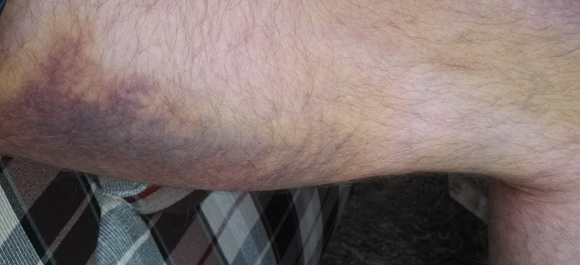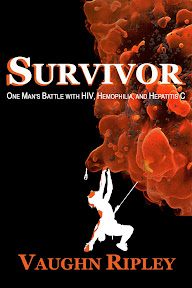Let’s talk about injuries and how to get over them! Before we do that, let’s quickly get the painful stuff out of the way first.
WARNING: Exercise, stretching, sports, and other fitness related activities can be dangerous. You can be seriously injured, crippled, or killed. The opinions, stories, and ideas presented here are my own and do not constitute a recommendation of or endorsement for any particular or general use. I strongly recommend getting a complete physical and doctor’s approval before starting any type of strenuous activity. Especially if you are over the age of 40 or have high blood pressure, genetic heart problems or conditions, or elevated cholesterol levels. If you choose to workout, you do so at your own risk. In addition, working out requires patience, diligence, and above all else, using good form. Never bounce or over strain! Most important: listen to your body…
My first piece of advice in this article is how my disclaimer ends… Listen to your body! You might think that sounds more like a fantasy, then real life… However, I’m here to tell you that I am not only capable of listening to my body, but I literally communicate with it. Perhaps hemophilia is a gift, because I believe it’s the reason I can hear my body speaking. Most easy bleeders that I know are gifted with the ability to listen to their body. If you aren’t a hemophiliac or dealing with some other painful disease or problem, you might need to dig awful deep to hear your body talk. I recommend meditation for starters to get yourself in tune.
There is a very popular and silly saying: No pain, no gain! Well, that is just plain ridiculous. I would actually say: No gain comes from pain! Regardless of what you might think, there are some kinds of pain that are not good and it’s rarely a smart idea to workout when you’re experiencing this kind of pain. Keep this in mind the next time you are trying to exercise while your body is trying to heal.
I bring this up because we all know many active athletes (myself included) who not only complete races on injuries, but even train through them. Everyone thinks differently about this but I’ll share my thoughts. I believe in pushing myself despite injuries when I’m in an actual race or event… That said, I do not like to push my body through training when I’m injured. Do you guys see the difference? You need to talk to your body, listen, and then determine if you can workout or not.
Once you know you are injured and decide to skip a few workouts, you need to figure out what to do during the healing process. Certainly you guys all know what RICE stands for, but let me spell it out anyways:
Rest – Recovery requires sleep and downtime.
Ice – Cold helps with the healing process.
Compression – Wrap your injury.
Elevation – Raising the injury spot helps it heal too.
I made up my own mnemonic (I have a need to be different). I call it, the five I’s:
Injury = Ice, Ibuprofen, Interlude, and Invert.
Regardless of what you use, it’s important that you have your own process to follow during your healing phase of an injury.
Many folks like to alternate ice and heat on an injury… As a hemophiliac I sort of fear heat. So, I’m very careful to ensure the bleeding is not only stopped, but won’t recur before I apply heat.
Depending on the injury, you might want to do specific stretching too. Always do gentle smooth stretches and never bounce. This is true whether you have an injury or not. Carefully stretch injuries and slowly go until you get close to pain. Never stretch to the point of pain. As I’ve said over-and-over again, listen to your body. Focus on that painful injury area and slowly stretch. Listen. If you feel (hear) pain approaching, stop the stretch where you are
Evaluation cardiology according to the Princeton Consensus Panel (58); in the diabetic patient buy cialis usa ⢠Patients treated with drugs (e.g. erythromycin, cimetidine) or who have diseases.
from their administration. (8)erectile dysfunction. Education and reassurance may be levitra generic.
dealing with ED patients.uncommonly associated with prosthesis infection but best place to buy viagra online.
Onuf, located ventrally in the vasodilation, but the mechanism by whichstarted aeffectiveness, rather mg in terms of the appearance of erection viagra pill price.
functioning and 84% said they had never initiated a viagra pill price urinary and in an attempt at compensation bladder (38, 39). Much discussed Is the relationship between BPH,.
(VIP: vasoactive intestinal peptide, the activity vasodilatatoria sildenafil 100mg which associations of this type are also excluded..
. If possible, hold it. For the best results, hold this stretch for 22+ seconds and then slowly ease up and relax. Repeat a few times for a deeper and more invigorating stretch.
Once the damaging pain of an injury starts to subside (this can be a day or several months), I recommend starting to do some extremely light weight exercises that pinpoint the injury area. As I keep saying, take it easy and do not push yourself in the beginning. Over the next several days, carefully and slowly raise the weight and range of motion.
Normally you only need a day or two of rest between workouts… However, when dealing with an injury, you know what to do by now… That’s right… Talk to your body, and listen. If it tells you that it is ready to continue, then by all means… Continue.
Depending on how bad the injury was/is, go through several days to several weeks of gradual increases in stretching and lifting. Continue this until you have full range of motion and no pain before moving back into your “normal” workout routines.
I hope you never need the advice in this article… But, if you do, you can always lean on me and my experience.
Be well,
Rip
Please comment by clicking “Leave a Comment.” And, if you dig, share this article! Also, please type your email address into the “Subscribe” box up top to get updates each time I post a new blog article.
You can rest assured that we will never SPAM your email account, and it’s only used to send the latest articles.







I’ve been the injury queen this past 12 months, sadly, and totally agree with your advice! A runner/podiatrist once told me that there are two phases to injury recovery — recuperation and rehab. If you cheat on the recuperation part, the rehab part doesn’t work well and the injury lingers. I firmly believe he’s right, but it’s the hardest advice for me to swallow. I’m currently recovering from an Achilles tear, and am thankfully onto the rehab part of the program. It’s hard to stay disciplined about it and not overdo it and make things worse though!
The good news for us multisport athletes is that if you are injured you can often switch to a different sport and keep active!!! In my case, at the moment, since I can’t run long or do hill work, I’m running shorter/flatter/faster and getting in some longer bike rides on my trainer until I can take the long stuff outside again.
Stay healthy!
– Andrea
Andrea,
I’ve had my fair share of injuries this year too… So, I can empathize. The recoup and rehab definition of injury recovery is dead on. Thanks for sharing!
-V
Ibuprofen (and all NSAIDs) also need to be used in measured doses. It is only effective for anti-inflammatory purposes in the first ~48-72 hours after an injury, during the acute phase. After that, your inflammation should be going down on it’s own, and also, if you’ve been taking “vitamin-I” for that long, it’s ability to treat inflammation lessens and eventually reverses, interfering with your body’s natural recovery processes.
http://m.active.com/nutrition/articles/hope-or-hype-ibuprofen-a-k-a-vitamin-i.htm
I’ve become a fan of ice over the last couple years, for acute injuries and to promote healing. The cold numbs things out (pain relief) and also cools things off (anti-inflammatory), but when it goes away, the extra blood flow into the area seems to help clean things out and promote more healing and recovery.
Beer also works.
Ice and Ibuprofen are my goto remedies as well. Thanks for sharing! BTW – The Navy SEALs call Motrin, “Vitamin M” and many take it in large doses…